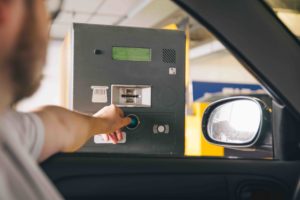 Parking: many consider it a blessing and a curse. When in a city, it’s a joy to find parking, but very frustrating when you can’t. If you live in the suburbs or rural areas, you may not even think about parking in the same way, as parking spots are often numerous and free. In most cities downtown areas, paying for parking is the norm, not the exception. Although people may gripe about this, paying for parking can provide numerous benefits to city residents, businesses and visitors alike, including increased turnover and more availability of parking spaces, reduced traffic congestion, parking facility cost savings and resources for economic development.
Parking: many consider it a blessing and a curse. When in a city, it’s a joy to find parking, but very frustrating when you can’t. If you live in the suburbs or rural areas, you may not even think about parking in the same way, as parking spots are often numerous and free. In most cities downtown areas, paying for parking is the norm, not the exception. Although people may gripe about this, paying for parking can provide numerous benefits to city residents, businesses and visitors alike, including increased turnover and more availability of parking spaces, reduced traffic congestion, parking facility cost savings and resources for economic development.
Why Managed and Paid Parking Matters
 Parking: many consider it a blessing and a curse. When in a city, it’s a joy to find parking, but very frustrating when you can’t. If you live in the suburbs or rural areas, you may not even think about parking in the same way, as parking spots are often numerous and free. In most cities downtown areas, paying for parking is the norm, not the exception. Although people may gripe about this, paying for parking can provide numerous benefits to city residents, businesses and visitors alike, including increased turnover and more availability of parking spaces, reduced traffic congestion, parking facility cost savings and resources for economic development.
Parking: many consider it a blessing and a curse. When in a city, it’s a joy to find parking, but very frustrating when you can’t. If you live in the suburbs or rural areas, you may not even think about parking in the same way, as parking spots are often numerous and free. In most cities downtown areas, paying for parking is the norm, not the exception. Although people may gripe about this, paying for parking can provide numerous benefits to city residents, businesses and visitors alike, including increased turnover and more availability of parking spaces, reduced traffic congestion, parking facility cost savings and resources for economic development.
Norwalk Parking Plan 2019
How Cities Are Incorporating Green Infrastructure To Help With Storm Surges
 As storms have become more frequent and more severe due to climate change, many cities have begun making changes to how they manage these types of incidences with green infrastructure initiatives. These initiatives are to reduce and handle the excess water that storms bring in to urban environments, and even use it to help the environment and economy.
As storms have become more frequent and more severe due to climate change, many cities have begun making changes to how they manage these types of incidences with green infrastructure initiatives. These initiatives are to reduce and handle the excess water that storms bring in to urban environments, and even use it to help the environment and economy.
Why We Need Green Infrastructure
Storm runoff is a greater problem in urban areas where pavement and other non-porous surfaces prevent much of it from soaking into the ground. When rains are particularly heavy erosion and flooding can occur causing damage to property and other infrastructure. Stormwater is also a major cause of pollution. The runoff can carry trash, bacteria and other pollutants with it. Traditionally, the infrastructure to move stormwater safely in cities includes pipes for drainage and water treatment systems.What Is Green Infrastructure?
Green infrastructure includes a variety of tactics to better soak up and/or store water. These could include adding more open space and vegetation such as gardens, planter boxes, green roofs, or swales (a shallow sunken channel) with plants and grasses to help absorb water. Cities can also change existing drainage to better trap and reuse water. For example, rerouting rooftop pipes from draining rainwater into the sewer to rain barrels or cisterns. Other more costly actions include adding permeable pavement that can soak up rainwater and perhaps evene store it. This pavement can be made of pervious concrete, porous asphalt, or permeable interlocking pavers. This practice could be particularly cost effective in areas where land values are high and flooding or icing is a major problem.Green Infrastructure in Norwalk
The recently completed Citywide Plan (POCD) recognizes the potential impacts and challenges that climate change poses. The City is beginning to discuss how to address these major challenges. The City is a registered member of Sustainable CT and will be seeking certification. In addition, the City has been considering green infrastructure incentives and requirements into its land use codes. While we are planning for our future, we are also implementing green infrastructure. In South Norwalk, the Webster Parking Lot will be installing green infrastructure after recent torrential rainfalls flooded nearby buildings several times, including the Bow Tie Cinema. The project envisions adding planters and other types of vegetation, including more trees, to help soak up the water in the lot before it goes into the drainage system. The city received an Environmental Protection Agency grant of $250,000 through the Long Island Sound Futures Fund to help finance the initiative. The project is being run by the office of Transportation, Mobility and Parking and the Department of Public Works. The green infrastructure will not only help ease flooding of the Webster Lot and make it more pleasant to look at, it will also help to keep Long Island Sound clean. Given the close proximity of the lot to the Sound, adding areas to absorb the water in the lot, means fewer pollutants will run into the Sound. Adding green infrastructure to the lot will prevent more than 6 million gallons of stormwater and 12 pounds of nitrogen from flowing into the Sound annually.Back-In Angled Parking Trend Comes To Norwalk
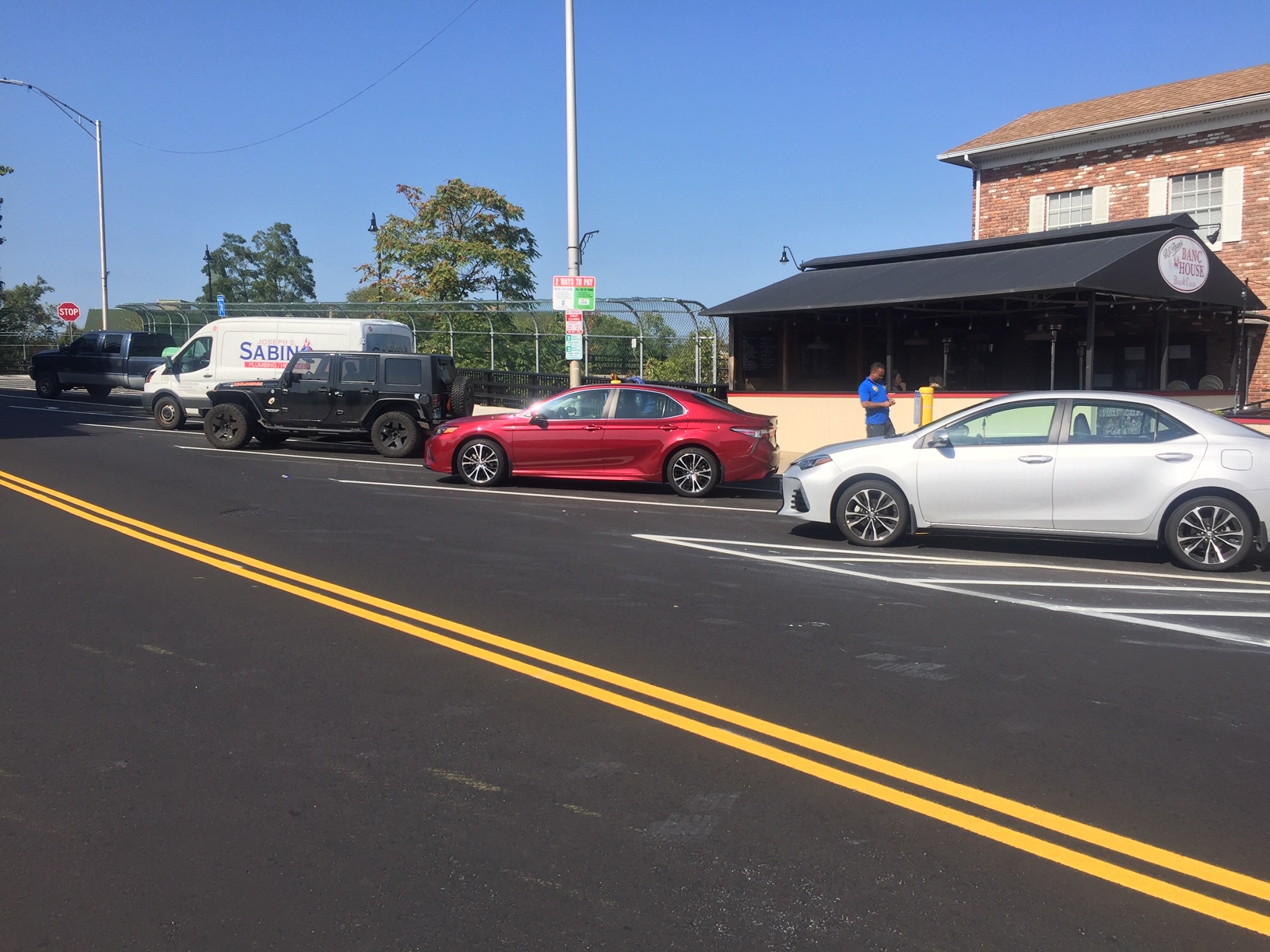 Back-in or reverse angled parking has become more and more popular over the last decade, especially among safety organizations like the National Highway Traffic SafetyAdministration, Insurance Institute for Highway Safety and AAA. This parking trend can be found throughout the United States from San Francisco, California, Tucson, Arizona, Missoula, Montana, Wilmington, Delaware, Syracuse, New York and now, Norwalk, Connecticut. Back-in angled parking is proven to be safer, a traffic calming measure, improves handicap parking and increases parking capacity.
Back-in or reverse angled parking has become more and more popular over the last decade, especially among safety organizations like the National Highway Traffic SafetyAdministration, Insurance Institute for Highway Safety and AAA. This parking trend can be found throughout the United States from San Francisco, California, Tucson, Arizona, Missoula, Montana, Wilmington, Delaware, Syracuse, New York and now, Norwalk, Connecticut. Back-in angled parking is proven to be safer, a traffic calming measure, improves handicap parking and increases parking capacity.
Benefits of Back-In Angled Parking
There are a lot of reasons why cities choose to move away from traditional parallel and towards the modern, back-in angled parking. As vehicles are modernized and advanced technology is incorporated into design, the challenges of unorthodox parking conventions become easier, simpler and safer. Parking Capacity: Angled parking provides more efficient use of space by creating 30%-40% more capacity versus parallel spaces. Traffic Calming: Angled parking requires more roadway, instead of curb space, thus decreasing travel lanes and shortening the width of the road, often making traffic move more slowly Safety: By reverse parking, you avoid backing out blindly into oncoming traffic or into the path of pedestrians. Back in angled parking also protects all of the passengers in the vehicle from the driver to the tiny, backseat passenger by protecting their exit and entrance out of the roadway. The National Highway Traffic Safety Administration (NHTSA) estimates that “267 people are killed and 15,000 injured each year by drivers not parking forward first, usually in driveways or parking lots.” Handicap Parking: Providing on-street handicap parking for parallel spaces is challenging with limited room for buffer zones to protect drivers and/or passengers. Back-in angled parking protects everyone and allows additional space for buffer zones at the beginning or end of each parking row. Cyclists: Back-in angled parking gives drivers an unobstructed view of motorists and cyclists resulting in increased awareness and decreased collisions due to line of sight issues.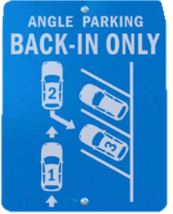 How to Park In Reverse-Angled Spaces
How to Park In Reverse-Angled Spaces
If you’ve never experienced back-in angled parking, no worries, it’s simple. While the maneuvers are not much different than those required for parallel parking, many people say it’s actually easier. You just drive slightly past the space, signal, and then back into the space. View the video below to see how it works.
Other Planning Efforts
The parking study and plan will be used to inform the Citywide Plan/POCD as well as planning for the Wall Street/West Avenue Neighborhood and the Transit Oriented Development plan around East Avenue, all of which are currently underway.
City Parking Trends
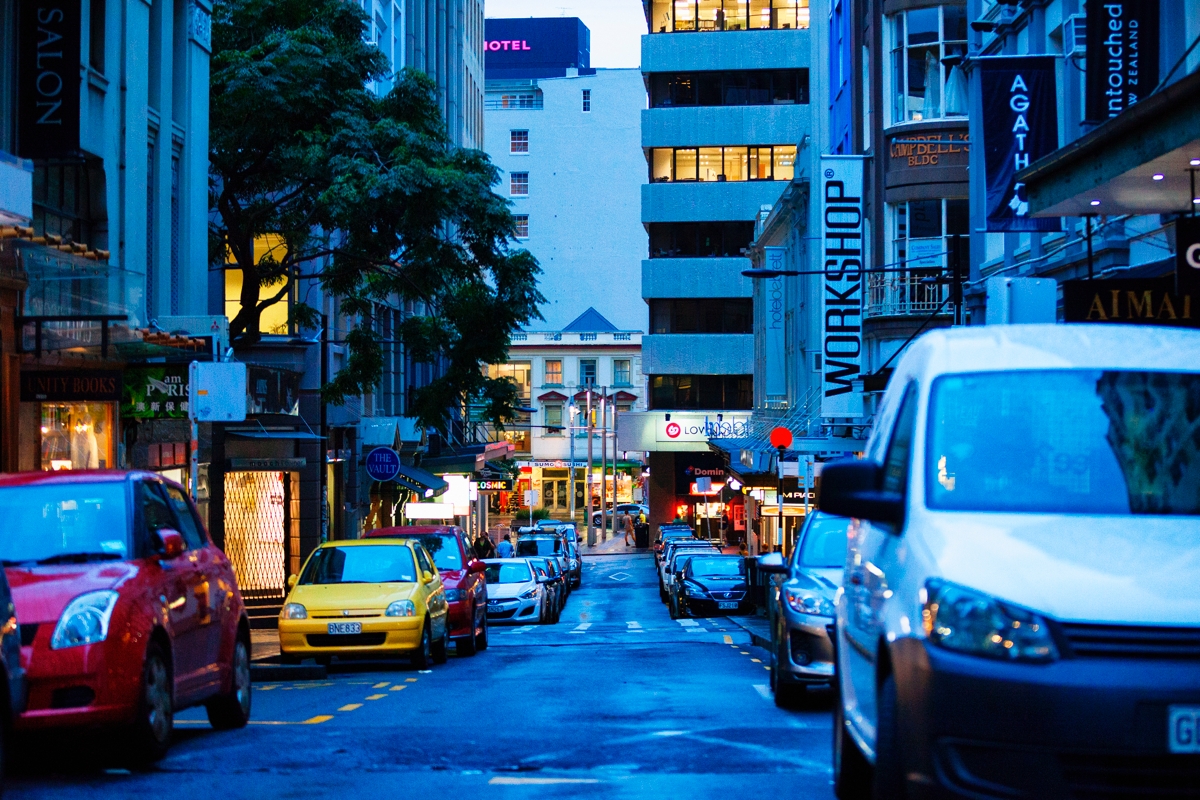 City parking. Some look at it as a necessary evil. Others as a godsend in a congested city. Either way, paid parking is here to stay and playing an ever-more important role as more and more people move into cities (also a recent trend). In fact, parking is now looked at by cities as part of the broader movement to ease traffic congestion and create more livable, walkable communities. There are a number of ways that parking has changed since the days of meter maids and coin-operated machine. Below are a few parking trends that we are seeing now that will continue in the future:
City parking. Some look at it as a necessary evil. Others as a godsend in a congested city. Either way, paid parking is here to stay and playing an ever-more important role as more and more people move into cities (also a recent trend). In fact, parking is now looked at by cities as part of the broader movement to ease traffic congestion and create more livable, walkable communities. There are a number of ways that parking has changed since the days of meter maids and coin-operated machine. Below are a few parking trends that we are seeing now that will continue in the future:
Parking Goes Digital: It’s All About The Technology
As in all aspects of modern life, parking has moved into the digital realm. Let’s review two of the ways that parking customers are now interacting with parking in the digital space.Payments Via Apps
The days of making sure you had change, in case you needed to feed the meter at the urban center, have gone by the wayside. Today, the parking industry is moving rapidly from cash to e-payments. Credit card payments and especially online payments through mobile phones are more and more common and are quickly become the norm.Finding Spaces: Way-finding Technologies
With GPS, cloud software, and mobile phones, municipalities are installing sensor space monitoring systems to allow parking customers to easily find open spaces on the street and in lots. These sensors give real-time data to drivers via smartphone apps, and in some cases through their vehicles, not only letting them know if spaces are available but showing them how to get there so they don’t waste time driving around. This helps out the driver but also the city, ensuring smoother traffic flows and reducing congestion. The future of parking is mobile with apps that provide real-time information on availability and guidance, and allow easy online payment. These technologies are beneficial to customers, making their parking experience seamless and hassle-free. They also help the parking industry’s next trend, making parking more environmentally friendly by reducing drive time looking for parking, which decreases fuel consumption and emissions.Energy Efficiency And Sustainable Solutions
Apps are one way parking is changing for customers, and helping the environment at the same time. But there are other, perhaps not as obvious, ways that parking is becoming more green. Parking facilities are striving for more energy efficiency by installing motion detection sensors and timers for lights, energy-efficient LED lighting, and solar powered meters and pay stations. These updates are not only better for the environment; they also save costs in long term use. In addition, the parking industry is encouraging greener, alternative modes of transportation. Electric car charging stations as well as special access and parking spaces for hybrids and electric vehicles are now common in parking lots. In addition, and perhaps counterintuitively, municipal parking facilities are adding areas for bicycle parking.Providing Alternatives To Driving Alone
The way we get around cities has changed drastically in the last few years with the need to drive your own car becoming less desirable. We’ve seen a rise in popularity of ride-sharing/on demand companies such as Uber and Lyft and an ever-increasing emphasis on the environment with cities providing more bike lanes and promoting mass-transit systems. Parking is now seen as more interconnected to all of these alternative transportation methods. Jumping on these trends, the parking industry itself is beginning to coordinate and operate car-sharing services and shuttles. We expect to continue to see the above trends in cities as the parking industry is seen more and more as a critical part a city’s economic development success. Parking is interconnected with transportation and mobility, impacting not only a city’s economy but also its liveability. Here in Norwalk, the Norwalk Parking Authority has already put in place many of the trends above. You can now drive to the urban areas of Norwalk such as SoNo or Wall Street and find available parking and make payments via mobile apps. Energy efficient lighting, car charging stations and bike parking areas are available in the South Norwalk Railroad Station, the Maritime Garage and other municipal lots. In addition, the Norwalk Transit District has just rolled out a pilot ride-sharing/on demand service called Wheels2U.Walker Parker Study
Liberty Square Parking Public Information Presentation
City Tries Out A SoNo to Wall Street Shuttle During Citywide Scavenger Hunt
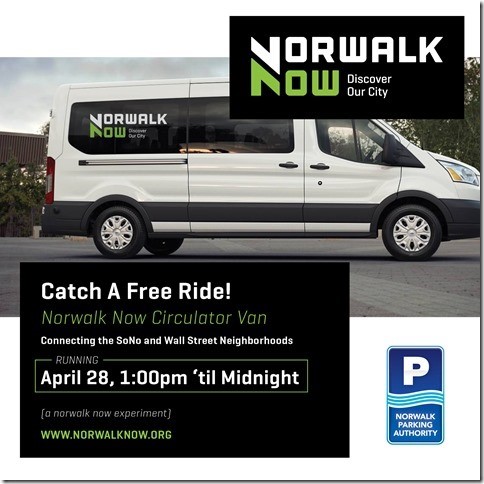 Those participating in the Citywide Scavenger Hunt on April 28th won’t have to get in their cars to search the city for clues. The Norwalk Parking Authority will be giving a trial run to a free shuttle from the Wall Street district to South Norwalk during the City Hunt.
The free shuttle will run from 1:00pm to 12 midnight on the day of the Scavenger Hunt, allowing people who are participating in the contest to get back and forth from SoNo to Wall Street. The vans are picking up and dropping off at several locations: in SoNo at the North Water Street Lot near the Maritime Aquarium’s IMAX entrance and the Maritime Garage, and in the Wall District in front of the Wall Street Theater and at the Yankee Doodle Garage. There will be parking attendants and signage.
The van service will also be available to people going out on the town that evening. The Parking Authority will monitor usage during this short period and evaluate to see if they will continue this service, perhaps on a limited basis.
“The idea of a shuttle circulating the two downtown areas of Norwalk has been discussed for a number of years. We thought that the Citywide Scavenger Hunt is a good opportunity to pilot the idea and gauge its popularity,” says Norwalk Mayor Harry Rilling. “I’ll be taking part in the hunt and riding the vans as well, and I look forward to talking to those who take advantage of this free service.”
The Citywide Scavenger Hunt will meet at O’Neill’s Pub & Restaurant at 10:30 a.m. on April 28. Participants will be “hunting” throughout the downtown districts for some several dozen clues, culminating in a party (to be disclosed during the hunt). There is a $40 entrance fee.
The Citywide Scavenger Hunt is being hosted by Norwalk Now, a part of MaxEx Public Relations, LLC, a marketing company that has entered a partnership with the Norwalk Parking Authority. The vans are provided and operated by LAZ Parking in collaboration with Norwalk Now and the Norwalk Parking Authority.
Norwalk Parking Authority works to develop programs that promote economic development and increase visitor activity in the downtown districts and the shuttle is part of that effort. “A circulator shuttle will help to make it easy for people to come downtown, enjoy a meal, go shopping, go to the movies, see a show and not have to worry about getting back in your car to go from one place to another,” says the Parking Authority’s director Kathryn Hebert.
Those participating in the Citywide Scavenger Hunt on April 28th won’t have to get in their cars to search the city for clues. The Norwalk Parking Authority will be giving a trial run to a free shuttle from the Wall Street district to South Norwalk during the City Hunt.
The free shuttle will run from 1:00pm to 12 midnight on the day of the Scavenger Hunt, allowing people who are participating in the contest to get back and forth from SoNo to Wall Street. The vans are picking up and dropping off at several locations: in SoNo at the North Water Street Lot near the Maritime Aquarium’s IMAX entrance and the Maritime Garage, and in the Wall District in front of the Wall Street Theater and at the Yankee Doodle Garage. There will be parking attendants and signage.
The van service will also be available to people going out on the town that evening. The Parking Authority will monitor usage during this short period and evaluate to see if they will continue this service, perhaps on a limited basis.
“The idea of a shuttle circulating the two downtown areas of Norwalk has been discussed for a number of years. We thought that the Citywide Scavenger Hunt is a good opportunity to pilot the idea and gauge its popularity,” says Norwalk Mayor Harry Rilling. “I’ll be taking part in the hunt and riding the vans as well, and I look forward to talking to those who take advantage of this free service.”
The Citywide Scavenger Hunt will meet at O’Neill’s Pub & Restaurant at 10:30 a.m. on April 28. Participants will be “hunting” throughout the downtown districts for some several dozen clues, culminating in a party (to be disclosed during the hunt). There is a $40 entrance fee.
The Citywide Scavenger Hunt is being hosted by Norwalk Now, a part of MaxEx Public Relations, LLC, a marketing company that has entered a partnership with the Norwalk Parking Authority. The vans are provided and operated by LAZ Parking in collaboration with Norwalk Now and the Norwalk Parking Authority.
Norwalk Parking Authority works to develop programs that promote economic development and increase visitor activity in the downtown districts and the shuttle is part of that effort. “A circulator shuttle will help to make it easy for people to come downtown, enjoy a meal, go shopping, go to the movies, see a show and not have to worry about getting back in your car to go from one place to another,” says the Parking Authority’s director Kathryn Hebert.Parking Minimums And How They Can Affect A City
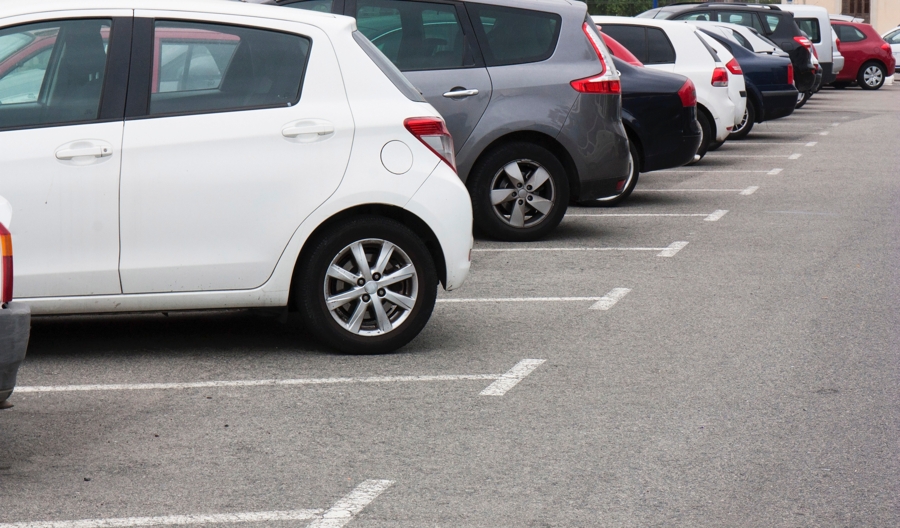 Hartford became the second major U.S. city to do away with mandatory parking minimums last year (Buffalo was the first). Parking minimums, which require builders to include a certain number of off-street parking spaces for buildings, have been popular the last 50+ years in many cities across the U.S. But what does this really mean for cities, and for its citizens?
Hartford became the second major U.S. city to do away with mandatory parking minimums last year (Buffalo was the first). Parking minimums, which require builders to include a certain number of off-street parking spaces for buildings, have been popular the last 50+ years in many cities across the U.S. But what does this really mean for cities, and for its citizens?
Parking and City Revenues
In cities, land is at a premium as they are constrained by the amount of land they can develop. It’s been argued that parking minimums fill cities with unproductive, parking spaces that don’t add value to the city and create barriers for new local businesses. With high minimum parking requirements for new buildings, there are more public and private garages, and parking gets favored versus buildings that can bring in higher tax revenues. Parking lots eat up a huge chunk of a city’s tax base. By enforcing parking minimums, the amount of productive land available for tax revenue is decreased. According to a 2014 study of several city downtowns, parking consumed so much land it amounted to $50 million a year in foregone tax revenue [1]. Another study also showed that parking minimums actually create a backwards tax incentive. Parking lots return 83 to 95 percent less property tax revenue to a city per acre than buildings do. This creates an incentive for landowners to tear down buildings and pave parking lots instead [2]. Two graphics from Urban3, an Asheville, NC based Urban Planning consulting firm, explain this well: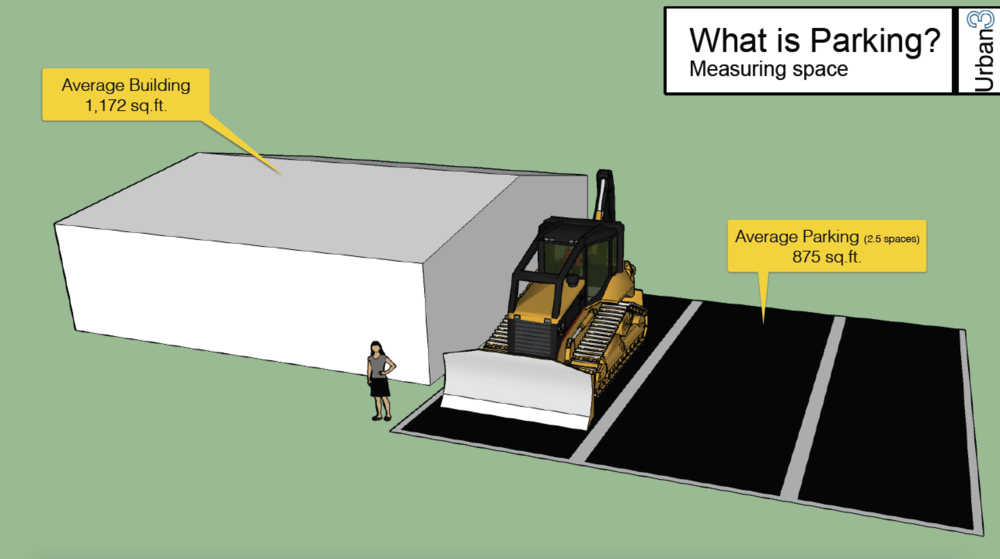 One parking space occupies 1.3 times the land that could have been used for a building - land that will frequently sit empty.
One parking space occupies 1.3 times the land that could have been used for a building - land that will frequently sit empty.
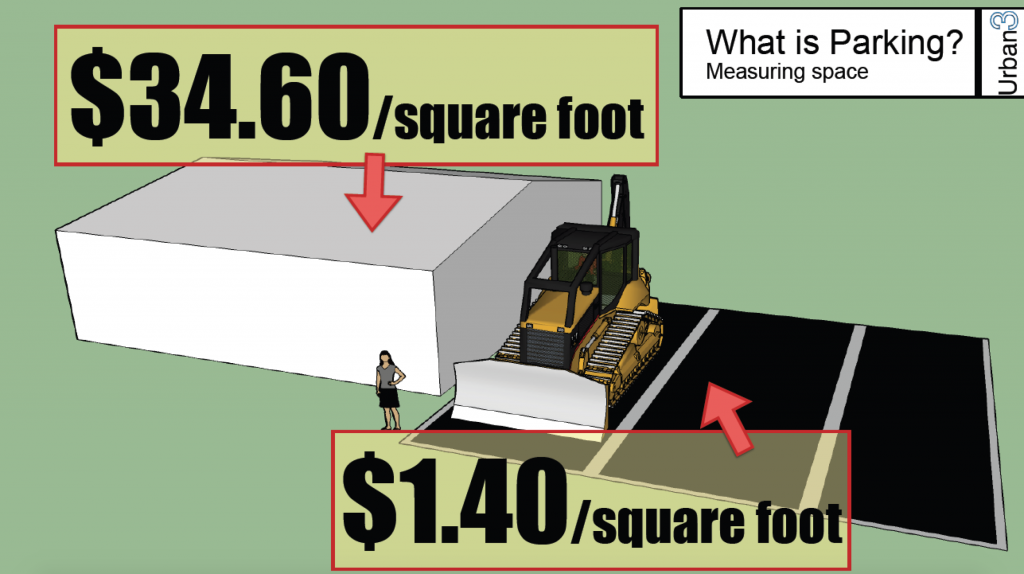
Parking Lots V.S. Building Stock
No minimums can help expand a downtown’s building stock. Without the burden of parking mandates, developers can more easily construct or renovate city buildings. Plus, the more parking spaces developers are required to create means less space for actual commercial space or residential units, which tends to raise rents. We can see an example of the effect of parking minimums on building stock by looking at some American small cities. Over the past 50 years, small cities such as Hartford or New Haven have devoted a large amount of space to parking. Other cities, such as Arlington, VA; Berkeley, CA; and Cambridge, MA; took a more restrictive approach to supplying ample parking. Over time in these latter three cities, off-street parking now takes up only five percent of land, while in other cities about 17% of land is devoted to parking.Parking and A Livable City
When a city mandates minimum parking, some important factors that make a modern “livable” city are ignored or removed. Many citizens express that they are looking for a city that is walkable, sprinkled with historic buildings and is as environmentally sustainable as possible. But, preservation gets short shrift from parking minimums as historic architecture is often replaced with parking. Parking minimums also encourage a “driving culture” for cities. With easy auto access, and easy parking, roads are more congested, hampering people’s ability to walk, bike, or take public transit. There are environmental implications to parking minimums as well. Convenient off-street parking promotes driving rather than encouraging the creation and use of efficient and expansive transit systems. With no parking minimums, traffic is reduced and there is less harmful runoff and greenhouse gas emissions. There is a big a tradeoff when considering the amount of parking in a city: either you have a dense, valuable urban area, or a location where it’s easy to drive. There are costs to parking minimums: inhibited development, loss of revenue for the city, higher cost of available space for consumers and businesses, and less reliance on and development of alternative means of transportation such as public transport or biking, to name a few. It may be time for more cities to consider doing a way with them.[1]. Dr. Norman Garrick, University of Connecticut's Center for Transportation and Livable Systems, 2014 [2] McCahill, Garrick, and co-authors Carol Atkinson-Palombo, Bryan Blanc, and Michael Gangi




